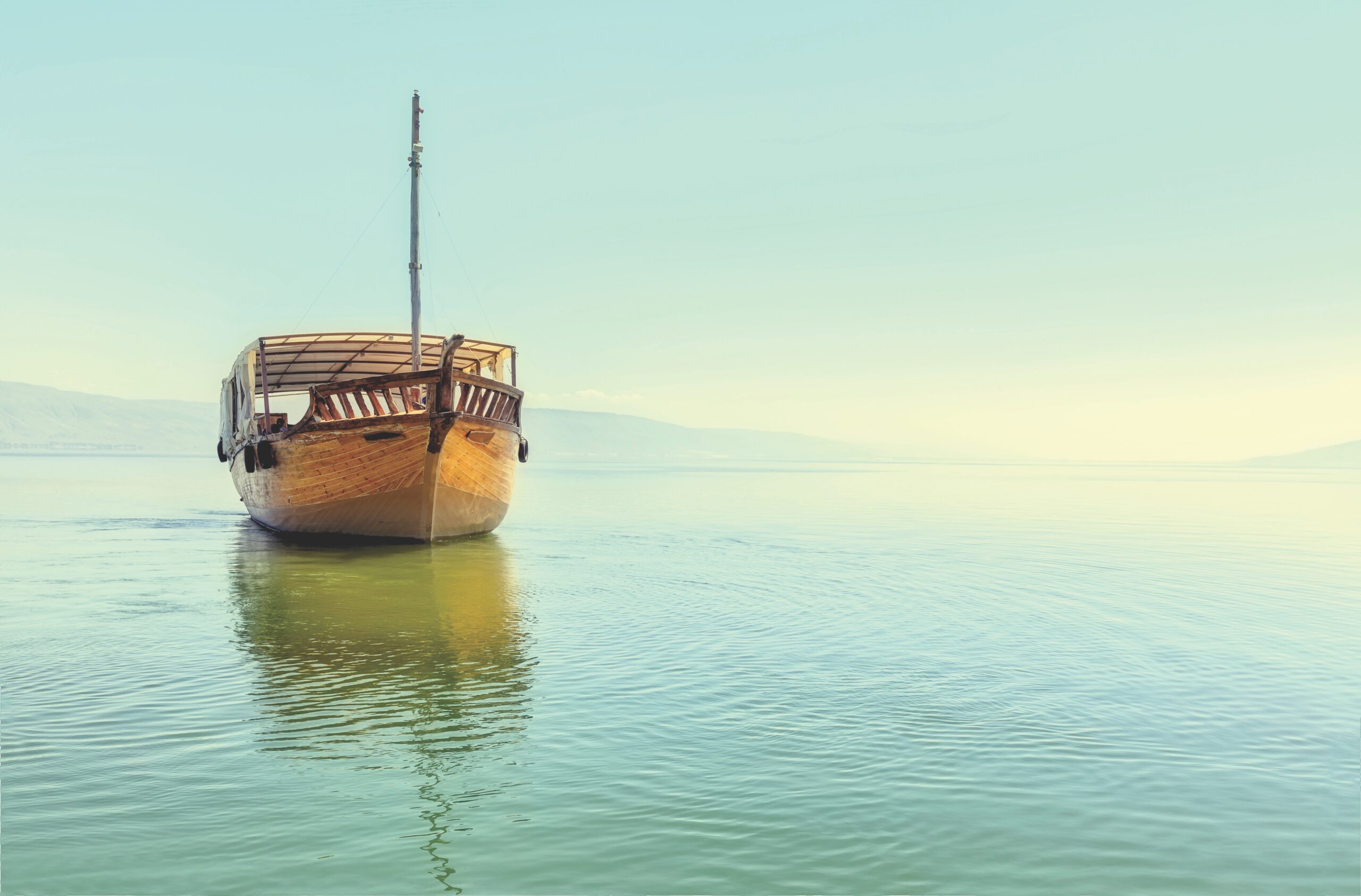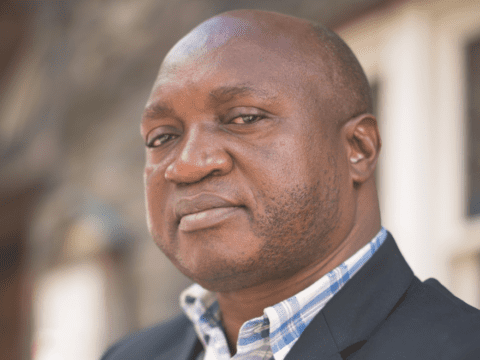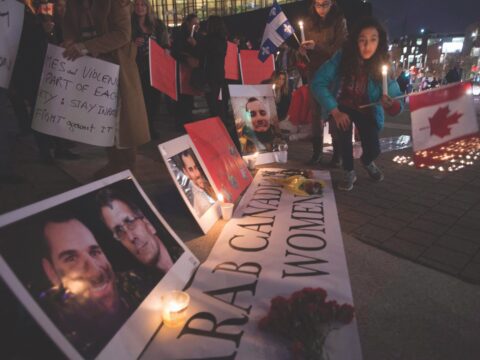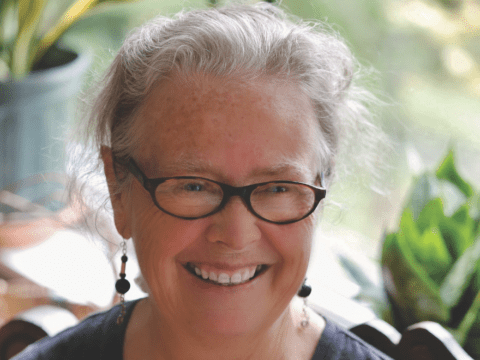We were nearing the end of our second day, having just examined the excavation of what is believed to be St. Peter’s house, with the Mount of Beatitudes in the background. Our large wooden boat left the dock at Capernaum, heading across the Sea of Galilee.
If we closed our eyes — as I noticed many of my travelling companions were doing — we might have fancied ourselves the disciples after a heavy day of fishing. As if on cue, the young fellows in charge of Holyland Sailing Trips cranked up the boom box. Amazing Grace, in the unmistakable voice of Elvis.
Being a tourist is a bit like going to the movies. You are asked to be passive and hand yourself over to some parallel reality. Yet if you do that, how can you engage with the “real” of the world you are travelling through? How do you see what’s just outside the frame?
“We” were a dozen journalists representing a variety of Canadian church-based publications, some accompanied by spouses or partners. In all, 20 people booked for six days of intensive touring around Israel — one holy site after another with a few wineries, bird sanctuaries and olive-oil pressing plants thrown in.
The purpose was in no way disguised: our host, Jerry Adler from the Toronto office of the Israel Ministry of Tourism, and our guide, Herzl Ein-Eli, a Bible-quoting Israeli who identifies as both Jewish and Christian, wanted their charges to enjoy Israel, particularly the dozens of sites all of us had known about since Sunday school.
We were then to promote similar tours to our readers back home. Tourism sits at number four in Israel’s economy, and officials want it to grow. The hope, the director general of the Ministry of Tourism told us at a dinner, is that 3.5 million visitors in 2012 (almost 100,000 from Canada) will become five million by 2015.
A big part of this picture is the religious tourism of Christians. Pilgrims from all over the world come here, wanting to visit the Sea of Galilee, the place where Joseph’s carpentry shop may have been in Nazareth, the hill where the 5,000 were fed with loaves and fishes, the manger site in Bethlehem.
Press trips are something tourism ministries everywhere provide for travel writers. As a charm offensive, this one worked: we were given a delightful tour, including moments of rapture for those who wanted, for example, to experience being baptized in the Jordan River. Underlying everything, though, were the sensitivities you could not avoid.
While the Holy Land belongs to everyone — Christians, Jews and Muslims all locate their most sacred sites here — it’s also a modern region with present-day occupants, not all of whom see eye to eye.
Visiting Israel is like being a guest in the home of a family that is having marital problems. The tensions simmer from the moment you come down for breakfast. Tourism officials insist that visitors “enjoy the sites” and seem perturbed should anyone want to get into the “Palestinian question.”
Yet it’s impossible to ignore either history or politics. Israel, as one person described it, “suffers from too much history, if such a thing is possible.”
Israel is a plucky little country that has done remarkable things since its founding by United Nations decree 65 years ago. It has created democratic institutions, a modern physical infrastructure, a highly competitive economy. Millions of acres of orchards and crops thrive on previously dry land watered by computer-controlled irrigation systems that direct scarce water only to the roots of the targeted plant.
All of this was accomplished while contending with the unremitting enmity of surrounding Arab states, fighting several wars and two intifadas on top of periodic threats from Lebanon and recurring skirmishes over Gaza. But in establishing itself, Israel displaced thousands of Palestinians with whom tensions remained so high that the territory was partitioned in 1995 — as it remains today, a kind of Swiss cheese of Palestinian pockets in greater Israel.
Tourism officials might want visitors (religious or not) to enjoy Israel without regard to the complications of politics. But politics, like history, is everywhere.
Joshua marched round Jericho and the walls fell down; millennia later, the Israel Defense Forces took the Golan Heights back from the Syrians. David avenged the deaths of Saul and Jonathan at the hands of the Amalekites 1,000 years before Christ; 3,000 years later, Israel attacked Gaza in response to Hamas’s rockets. The thread of history does not end at some magical moment. Nor are today’s politics any less relevant or less interesting than those of two or three millennia ago.
On day five, we went to Bethlehem. There is no way to gloss over the dramatic transition from Israel into this other place with many names — occupied territory, Palestinian Authority, West Bank. There are not (yet) two states officially, but there might as well be. A bare 15 kilometres south of Jerusalem, the town of Christ’s birth is entered through a high-security gate with tire-shredding blades on the road. Your passport is demanded, your handbags or luggage potentially checked.
Looking through the window, you can see Palestinians with permits (reportedly only two percent of the population) making their way through the thorough security search that is part of their daily routine as they head to work. On both sides stretches the security fence — a wall, really, a canvas for angry graffiti on the Palestinian side, a symbol of dispiriting control. To the left is one of a number of newly constructed settlements considered illegal by both the United Nations and the United States.
What ought to be a simple passage from Jerusalem into Bethlehem encapsulates all the problems Jesus came to rectify. At the border, Adler and Ein-Eli left our bus. When asked why he was not accompanying us, Adler explained, “I would not feel welcome. It would be uncomfortable.”
After our driver took us through, we immediately exited our bus with its Israeli plates, boarded a smaller one with Palestinian plates and were greeted by our new guide, Husan Yacob. As the next few hours passed, this pleasant young fellow would counter every passing comment our Israeli guide had made over the previous days about dangers and threats from Palestinians with his complaints about the burdensome regulations, provocations, grievances, indignities and sometimes outright brutalities he and his compatriots suffered at the hands of the Israelis.
Our first stop was a treed hillside where the shepherds on a long-ago Christmas Eve may or may not have been startled by the bright star and heard the angel’s instructions to fear not. According to the Roman Catholics, who have constructed a pretty little church atop the hill, this is the spot. But the Greek Orthodox, who have constructed their own church on another hill a mile or so away, think otherwise. And so it goes.
Back in Jerusalem, Rev. Pierbattista Pizzaballa knitted his fingers nervously when asked about the challenges of juggling, sharing and maintaining the myriad of shrine sites in this crowded country with so many layers of history. An Italian, Pizzaballa is the Catholic Church’s official custodian of holy sites in the Holy Land, a responsibility his Franciscan order has held for eight centuries. In total, they oversee 49 sites, 46 of them in Israel, including the memorial to St. Peter in Capernaum and the Cenacle or Upper Room, said to be where the Last Supper was held, on Mount Zion in Jerusalem.
The crown jewel of the collection is Bethlehem’s Church of the Nativity, which sits above the very place where the manger supposedly stood in a stable — or more likely a cave. The grotto is reached by carefully descending some 16 slippery stone steps underneath the altar, then kneeling down to part a heavy red curtain, revealing a silver star on the floor that marks the spot where Jesus is believed to have been born.
The basilica overtop the site was built in the fourth century by the Roman emperor Constantine and has gone through numerous transitions since, each leaving its mark. The Crusaders controlled the site for two centuries, bricking up the formerly large door so that enemies could not ride in on horseback, and installing gold-leaf frescoes high on the walls.
Today, the Greek Orthodox, Armenian Orthodox and Roman Catholic overseers negotiate laboriously over everything from the hours priests from each denomination can monopolize the altar area for their daily prayers, to how to handle the crowds of tourists and pilgrims.
On our visit, a two-hour-long line began forming around 11 a.m. Queue jumping was a constant threat and annoyance. At one point, guards halted our progress completely in order to give an Orthodox bishop and his VIP entourage priority. Twenty minutes later, they emerged from the grotto and we were allowed to proceed.
Not everyone considered the visit an uplifting experience. After the long wait — not just the hours in line but the wait of an entire lifetime to make such a special trip — some emerged from the grotto spilling tears of frustration.
The place of Christ’s birth was a bit of a zoo, from the elbowing to get into position to take the photos everybody deemed they needed, to being pushed by security officers wanting to keep the lines moving. Pizzaballa acknowledged such problems, estimating that 90 percent of people visiting holy sites are religious tourists needing a simple, cursory look, while 10 percent are pilgrims who want to pray and revel in the experience. And the tourism industry’s desire for ever-greater numbers as often as not runs up against the need to protect the integrity of sites and maximize the visitor experience.
The big change recently is where pilgrims are coming from — not just Europe and America, but China, Brazil, Africa, Asia, India, Russia. We encountered busloads from South Africa, Kenya and Nigeria. At one of the Golgotha sites, a congregation of well over 100 from the Philippines was carrying on a lengthy worship service, their boisterous singing drowning out a nearby group of 30 or so Nigerians trying to sing their own hymns.
Rev. Mitri Raheb, a Palestinian who since 1992 has headed a group of Lutheran-based education and social service initiatives in the Bethlehem area, sees tourism’s challenges in a different light than either Adler or Pizzaballa. Raheb laments what he colourfully describes as groups coming to the Holy Land “to run on the paths where Jesus walked.” Eighty percent of tourists who come to Bethlehem, he claims, take a quick look at the Church of the Nativity before heading back to hotels in Jerusalem.
The problem, from his standpoint, is that this leaves minimal economic benefit for Bethlehem or the Palestinian Authority, as well as minimal cultural impact on the visitor who might benefit from experiencing “this side of the story.” Raheb would like to promote what he calls a more “authentic” tourism. But what does this mean, exactly?
Israel’s tourism initiatives have a targeted audience. Jerry Adler acknowledges that he spends a good portion of his Canadian advertising budget through media such as CTS (the Christian Television Service), cultivating people like televangelist David Mainse of 100 Huntley Street and buying radio spots in places like Red Deer, Alta. — “deep in the Bible belt.”
Evangelical Christians are where the action is for religious tourism. For critics, this strategy is not entirely benign. An article in the Christian Science Monitor last February describes a growing band of Christians around the world “who see support for Israel as a divine calling.” The piece claims that Israel not only encourages their love of the Holy Land but also increasingly courts their political support.
Evangelical Christians, for example, tend to oppose the boycott, divestment and sanctions movement against Israel, a campaign that has attracted more left-leaning Christians in North America and Europe. The United Church of Canada, while rejecting an Israel-wide boycott, called for economic action last year against products produced in the settlements.
Of course, Palestinians also look to audiences perceived as sympathetic to their cause, and other interests similarly want to put their side of things forward. Prior to the trip, I received an invitation to visit the Israeli human rights group B’Tselem. While Israel might be sensitive to external criticism, few societies are as self-critical, whether it be organizations like B’Tselem or writers in some of the country’s 20-plus daily newspapers.
On the day I met with B’Tselem’s public affairs spokesperson Sarit Michaeli, she was preoccupied with a skirmish the night before during a protest at a Palestinian refugee camp south of Hebron. A Molotov cocktail had been thrown, police and military moved in and, by the time all was done, a 22-year-old young man, one of the protesters, lay dead. Sadly, this was not an uncommon turn of events; 14 Palestinian protesters had died so far in 2013, and it was only early March.
Michaeli sees B’Tselem, founded in 1989 to respond to human rights issues in the West Bank during the first intifada, as her country’s conscience. “Our job is to criticize and try to improve our own country’s human rights record,” she told me. To do that, the 40 staff members investigate every clash between Israeli security forces and Palestinians. “We may not be the most popular organization in Israel,” she said, “but our research is respected.”
Sharing this information with an outsider seemed important, not just to increase my knowledge but to provide a rounded view of the multi-dimensional country we were in. “It is vital,” the invitational email had stated, “that alongside the Tourism Ministry tour you also see the reality of the Israeli occupation and our human rights concerns.” The words hinted at something about the potential of tourism. Tour guides are understandably frustrated when tourists don’t want to stick to the iconic sites — much as Canadians trying to show off Niagara Falls might feel about visitors who insist on seeing Attawapiskat instead.
They would prefer guests like the Canadian who told me she didn’t want to know about “all that stuff” but just wanted to “travel with [her] Bible.” And while it’s certainly okay to travel with just your Bible, it’s also worth considering how both the industry and the experience might be tweaked to more greatly benefit both hosts and visitors — what Raheb might well have meant by his term “authentic” tourism.
At present, Israel and the Palestinian Authority have parallel tourism ministries, though the Palestinian one is obviously much smaller. If you go on a Palestinian tour, you experience quite a different country despite travelling within the same limited space. One has to wonder whether it might it be possible for everybody, visitors and hosts alike, to tear down some borders to create something more like a shared tourism. One in which the average tourist won’t miss out on this complicated region’s layered dimensions — and learn to appreciate its many nuances.
***
This story first appeared in The United Church Observer’s October 2013 issue with the title “The land of too much history.”














